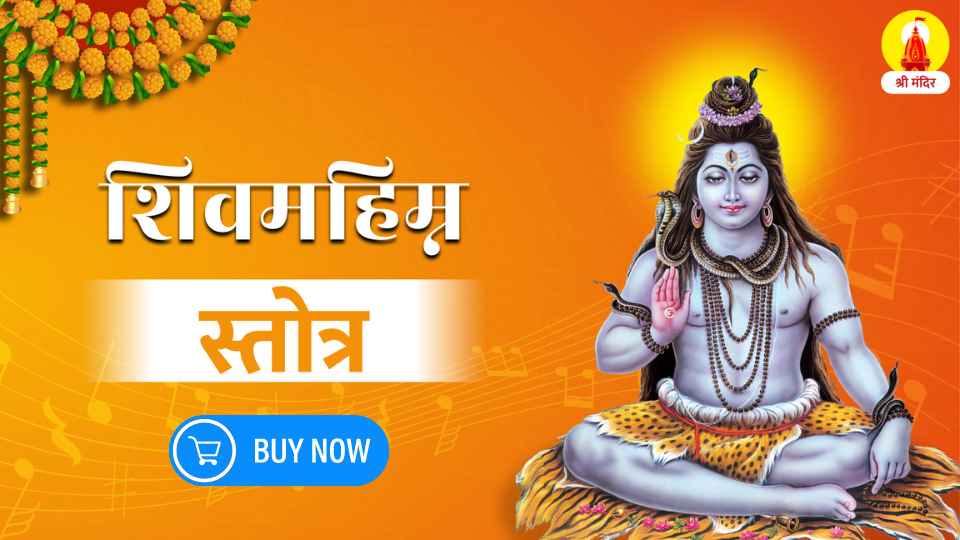शिव महिम्न स्तोत्र – In the realm of Hindu spirituality, there exists a treasure trove of hymns and prayers dedicated to various deities. Among them, the Shiv Mahimna Stotra stands as a profound expression of devotion towards Lord Shiva, the supreme being of the Shaivism tradition. This blog embarks on a journey to unravel the depths of this sacred composition, exploring its significance, origin, and the divine attributes it extols.

शिव महिम्न स्तोत्र
1. शिवमहिम्न स्तोत्र पाठ विधि:
- शिवमहिम्न स्तोत्र पाठ से पहले शिवलिंग का कच्चे दूध और जल से अभिषेक करें।
- इसके बाद धूप, दीप, पुष्प और नैवेद्य अर्पित करें।
- पूजा के बाद शिवमहिम्न स्तोत्र का पाठ करें।
2. शिवमहिम्न स्तोत्र से लाभ:
- इस स्तोत्र के जाप से डर पर काबू पाने में मदद मिलती है।
- इस स्तोत्र के जाप से भगवान शिव की दिव्य कृपा प्राप्त होती है।
- इस स्तोत्र के जाप से मनुष्य के सारे पाप नष्ट हो जाते हैं।
3. शिवमहिम्न स्तोत्रम् – मूल पाठ
अथ श्री शिवमहिम्नस्तोत्रम्
पुष्पदंत उवाच
महिम्नः पारन्ते परमविदुषो यद्यसदृशी।
स्तुतिर्ब्रह्मादीनामपि तदवसन्नास्त्वयि गिरः॥
अथावाच्यः सर्वः स्वमतिपरिमाणावधि गृणन्।
ममाप्येष स्तोत्रे हर निरपवादः परिकरः॥1॥
अर्थ:
श्री पुष्पदंत जी कहते हैं कि हे प्रभु ! बड़े बड़े विद्वान और योगीजन आपके महिमा को नहीं जान पाए तो मैं तो एक साधारण बालक हूं, मेरी क्या गिनती ?
लेकिन क्या आपके महिमा को पूर्णतया जाने बिना आपकी स्तुति नहीं हो सकती? मैं ये नहीं मानता क्योंकि अगर ये सच है तो फिर ब्रह्मा की स्तुति भी व्यर्थ कहलाएगी।
मैं तो ये मानता हूँ कि सबको अपनी मति अनुसार स्तुति करने का अधिकार है। इसलिए हे भोलेनाथ ! आप कृपया मेरे हृदय के भाव को देखें और मेरी स्तुति को स्वीकार करें॥
अतीतः पन्थानं तव च महिमा वाङ्मनसयो:।
रतदव्यावृत्या यं चकितमभिधत्ते श्रुतिरपि।।
स कस्य स्तोतव्यः कतिविधिगुणः कस्य विषयः।
पदे त्वर्वाचीने पतति न मनः कस्य न वचः ॥2॥
अर्थ:
हे शिव !!! आपकी व्याख्या न तो मन और न ही वचन द्वारा संभव है। आपके संदर्भ में वेद भी अचंभित हैं तथा ‘नेति नेति’ का प्रयोग करते हैं अर्थात ये भी नहीं और वो भी नहीं। आपकी महिमा और आपके स्वरूप को पूर्णतया जान पाना असंभव है, लेकिन जब आप साकार रूप में प्रकट होते हो तो आपके भक्त आपके स्वरूप का वर्णन करते नहीं थकते। ये आपके प्रति उनके प्यार और पूज्य भाव का परिणाम है॥
मधुस्फीता वाचः परमममृतं निर्मितवत:।
स्तवब्रह्मन्किवागपि सुरगुरोविस्मय पदम्।।
मम त्वेतां वाणों गुणकथनपुण्येन भवतः।
पुनामीत्यर्थेऽस्मिन् पुरमथनबुद्धिर्व्यवसिता ॥3॥
अर्थ:
हे वेद और भाषा के सृजन ! आपने अमृतमय वेदों की रचना की है। इसलिए जब देवों के गुरु, बृहस्पति आपकी स्तुति करते हैं तो आपको कोई आश्चर्य नहीं होता। मैं भी अपनी मति अर्थात ज्ञान के अनुसार आपका गुणानुवाद करने का प्रयास कर रहा हूं। मैं मानता हूं कि इससे आपको कोई आश्चर्य नहीं होगा, मगर मेरी वाणी इससे अधिक पवित्र और लाभान्वित अवश्य होगी ||
तवैश्वर्यं तत्तज्जगदुदयरक्षा प्रलयकृत्।
त्रयीवस्तुव्यस्तं तिसृषु गुणभिन्नासुतनुषु ॥
अभव्यानामस्मिन्वरद रमणीयामरमणीम्।
विहन्तु व्याक्रोशीं विदधत इहैके जडधियः ॥4॥
अर्थ:
हे देव ! आप इस सृष्टि के सृजनहार है, पालनहार है और विसर्जनकार अर्थात संहार करने वाले हैं। इस प्रकार आपके ब्रह्मा, विष्णु और महेश तीन स्वरूप हैं। तथा आप में सत्व, रज और तम तीन गुण भी हैं । वेदों में इनके बारे में वर्णन किया गया है फिर भी अज्ञानी लोग आपके बारे में ऊटपटांग बातें करते रहते हैं। ऐसा करने से भले ही उन्हें संतुष्टि मिलती हो, किन्तु यथार्थ से वो मुंह नहीं मोड़ सकते ॥
किमीहः किङ्कायः स खलु किमुपायस्त्रिभुवनम्।
किमाधारो धाता सृजति किमुपादान इति च॥
अतक्यैश्वर्ये त्वय्यनवसरदुःस्थो हतधियः।
कुतर्कोऽयं कांश्चिन्मुखरयति मोहाय जगतः॥5॥
अर्थ:
हे महादेव ! मूर्ख लोग अक्सर तर्क करते रहते है कि ये सृष्टि की रचना कैसे हुई, किसकी इच्छा से हुई, किन वस्तुओं से उसे बनाया गया इत्यादि। उनका उद्देश्य लोगों में भ्रांति पैदा करने के अलावा कुछ नहीं है। सच पूछो तो ये सभी प्रश्नों के उत्तर आपकी दिव्य शक्ति से जुड़े हैं और मेरी सीमित शक्ति से उसे व्यक्त करना असंभव है॥
अजन्मानो लोकाः किमवयववन्तोऽपि जगतां।
मधिष्ठातारं किं भवविधिरनादृत्य भवति॥
अनीशो वा कुर्याद्भुवनजनने कः परिकरो।
यतोमन्दास्त्वां प्रत्यमरवर संशेरत इमे ॥6॥
अर्थ:
हे परमपिता! यह सात लोक आपके द्वारा ही बनाया गया है, इसके कर्ता आपके अतिरिक्त दूसरा कोई नहीं हो सकता, क्योंकि इस विचित्र संसार की विचित्र रचना की सामग्री दूसरे के पास होना असंभव है। इसलिए अज्ञानी लोग ही आपके विषय में संदेह करते हैं॥
त्रयी सांख्यं योगः पशुपतिमतं वैष्णवमिति।
प्रभिन्न प्रस्थाने परमिदमदः पथ्यमिति च॥
रुचीनां वैचित्र्यादृजुकुटिलनानापथजुषां।
नृमाणेको गम्यस्त्वमसि पयसामर्णव इव ॥7॥
अर्थ:
हे शिव ! आपको पाने के लिए अनगिनत मार्ग है – सांख्य मार्ग, वैष्णव मार्ग, शैव मार्ग, वेद मार्ग आदि। लोग अपनी रुचि के अनुसार कोई एक मार्ग को पसंद करते है। मगर आखिरकार ये सभी मार्ग, जैसे अलग अलग नदियों का पानी बहकर समुद्र में जाकर मिलता है, वैसे ही, यह सभी मार्ग आप तक पहुंचाते हैं। सचमुच, किसी भी मार्ग का अनुसरण करने से आपकी प्राप्ति हो सकती है ॥
महोक्षः खट्वांग म्परशुरजिनं भस्म फणिनः।
कपालंचेतीयत्तव वरद तन्त्रोपकरणम्॥
सुरास्तां तामृद्धिं दधति तु भवद्भ्द्ध प्रणिहिताम्।
न हि स्वात्मारामं विषय मृगतृष्णा भ्रमयति।। 8।।
अर्थ:
हे शिव ! आपके भृकुटी के इशारे मात्र से सभी देवगण ऐश्वर्य एवं संपदाओं का भोग करते हैं। पर आपके स्वयं के लिए सिर्फ कुल्हाड़ी, बैल, व्याघ्रचर्म, शरीर पर भस्म तथा हाथ में खप्पर (खोपड़ी)! इससे ये फलित होता है कि जो आत्मानंद में लीन रहता है वो संसार के भोग पदार्थों में नहीं फंसता॥
ध्रुवं कश्चित्सर्वं सकलमपरस्त्वद्ध वमिदम्।
परोधौव्याध्रौव्ये जगति गदति व्यस्तविषये॥
समस्तेऽप्येतस्मिन्पुरमथन तैविस्मित इव।
स्तुवज्ञ्जिद्देमि त्वां न खलु ननु धृष्टा मुखरता।।9।।
अर्थ:
हे त्रिपुरहंता ! इस संसार के बारे में विभिन्न विचारकों के भिन्न-भिन्न मत हैं। कोई इसे नित्य जानता है तो कोई इसे अनित्य समझता है। लोग जो भी कहें, आपके भक्त तो आपको हमेशा सत्य मानते है और आपकी भक्ति में आनंद पाते है। मैं भी उनका समर्थन करता हूँ, चाहे किसी को मेरा ये कहना धृष्टता लगे, मुझे उसकी परवाह नहीं।।
तवैश्वर्यं यत्नाद्यदुपरिविरंचिर्हरिरधः।
परिच्छेत्तु यातावनलमनलस्कन्धवपुषः॥
ततोभक्ति श्रद्धाभरगुरुगृणद्भ्यां गिरिश यत्।
स्तयं तस्थे ताभ्यां तव किमनुवृत्तिर्न फलति।।10।।
अर्थ:
हे प्रभु ! जब ब्रह्मा और विष्णु के बीच विवाद हुआ की दोनों में से कौन महान है, तब आपने उनकी परीक्षा करने के लिए अग्नि स्तंभ का रूप लिया। ब्रह्मा और विष्णु – दोनों ने स्तंभ को अलग अलग छोर से नापने की कोशिश की मगर वो सफल न हो सके। आखिरकार अपनी हार मानकर उन्होंने आपकी स्तुति की, जिससे प्रसन्न होकर आपने अपना मूल रूप प्रकट किया। सचमुच, अगर कोई सच्चे दिल से आपकी स्तुति करे और आप प्रकट न हों क्या ऐसा कभी हो सकता है भला ।।
अयत्नादापाद्यत्रिभुवनमवैरव्यतिकरम्।
दशास्यो यद्बाहूनभृत रणकण्डूपरवशान्॥
शिरः पद्मश्रेणोरचितचरणाम्भोरु हबलेः।
स्थिरायास्त्वद्भक्तेस्त्रिपुरहर वियस्फूर्जितमिदम् ॥11॥
अर्थ:
हे त्रिपुरान्तक ! आपके परम भक्त रावण ने पद्म की जगह अपने नौ-नौ मस्तक आपकी पूजा में समर्पित कर दिये। जब वो अपना दसवां मस्तक काटकर अर्पण करने जा रहा था, तब आपने प्रकट होकर उसको वरदान दिया। इस वरदान की वजह से ही उसकी भुजाओं में अटूट बल प्रकट हुआ और वो तीनो लोक में शत्रुओं पर विजय पाने में समर्थ रहा। ये सब आपकी दृढ़ भक्ति का नतीजा है॥
अमुष्य त्वत्सेवा समधिगतसारं भुजवनम्।
बलाकैलासेऽपि त्वदधिवसतौविक्रमयतः॥
अलभ्या पातालेऽप्यलसचलितांगु ष्ठशिरसि।
प्रतिष्ठा त्वय्यासीद् ध्रुवमुपचितो मुह्यति खलः।।12।।
अर्थ:
हे शिव ! आपकी परम भक्ति से रावण अतुलित बल का स्वामी बन बैठा मगर इससे उसने क्या करना चाहा ? आपकी पूजा के लिए हर रोज कैलाश जाने का श्रम बचाने के लिए कैलाश को उठाकर लंका में गाड़ देना चाहा। जब कैलाश उठाने के लिए रावण ने अपनी भुजाओं को फैलाया तब पार्वती भयभीत हो उठीं। उन्हें भयमुक्त करने के लिए आपने सिर्फ अपने पैर का अंगूठा लगाया तो रावण जाकर पाताल में गिरा और वहां भी उसे स्थान नहीं मिला। सचमुच, जब कोई आदमी अनधिकृत बल या संपत्ति का स्वामी बन जाता है तो उसका उपयोग करने में विवेक खो देता है।।
यदृद्धि सुत्राम्णो वरद! परमोच्चैरपि सती।
मधश्चक्र बाणः परिजनविधैयस्त्रिभुवनः॥
नतच्चित्रं तस्मिन्वरिवसिरित्वच्चरणयोः।
न कस्याप्युन्नत्यं भवति शिरसस्त्वय्यवनतिः ॥13॥
अर्थ:
हे शम्भो ! आपकी कृपा मात्र से ही बाणासुर दानव इन्द्रादि देवों से भी अधिक ऐश्वर्यशाली बन गया तथा तीनों लोकों पर राज किया। हे ईश्वर ! जो मनुष्य आपके चरण में श्रद्धा भक्तिपूर्वक शीश रखता है उसकी उन्नति और समृद्धि निश्चित है।।
अकाण्ड: ब्रह्माण्ड क्षयचकितदेवासुरकृपा।
विधेयस्याऽसीद्यस्त्रिनयन विषं संह तवतः ।।
स कल्माषः कण्ठे तव न कुरुते न श्रियमहो।
विकारोऽपिश्लाघ्यो भुवनभयभगंव्यसनिनः ॥14॥
अर्थ:
हे प्रभु ! जब समुद्र मंथन हुआ तब अन्य मूल्यवान रत्नों के साथ महाभयानक विष निकला, जिससे समग्र सृष्टि का विनाश हो सकता था। आपने बड़ी कृपा करके उस विष का पान किया। विषपान करने से आपके कंठ में नीला चिन्ह हो गया और आप नीलकंठ कहलाये। परंतु हे प्रभु, क्या ये आपको कुरूप बनाता है? कदापि नहीं, ये तो आपकी शोभा को और बढ़ाता है। जो व्यक्ति औरों के दुःख दूर करता है उसमें अगर कोई विकार भी हो तो वो पूजा पात्र बन जाता है।।
असिद्धार्था नैव क्वचिदपि सदेवासुरनरे।
निवर्तन्ते नित्यं जगति जयिनो यस्य विशिखाः।।
स पश्यन्नीश त्वामितरसुरसाधारणमभूत्।
स्मरः स्मर्तव्यात्मा न हि वशिषु पथ्यः परिभवः।। 15।।
अर्थ:
हे प्रभु ! कामदेव के वार से कभी कोई भी नहीं बच सका चाहे वो मनुष्य हों, देव या दानव हो। पर जब कामदेव ने आपकी शक्ति समझे बिना आप की ओर अपने पुष्प बाण को साधा तो आपने उसे तत्क्षण ही भस्म कर दिया। यह जगत प्रसिद्ध है कि श्रेष्ठ जनों के अपमान का परिणाम हितकर नहीं होता।।
मही पादाघाताद्व्रजति सहसा संशयपदम्।
पदं विष्णोर्भ्राम्यद्भुजपरिघरुग्णग्रहगणम्॥
मुहुर्योदौस्थ्यं यात्यनिभृतजटाताडिततटा।
जगद्रक्षायै त्वं नटसि ननु वामैव विभुता॥ 16॥
अर्थ:
हे नटराज !!! जब संसार के कल्याण हेतु आप तांडव करने लगते हैं तब समग्र सृष्टि भय के मारे कांप उठती है, आपके पद प्रहार से पृथ्वी अपना अंत समीप देखती है ग्रह नक्षत्र भयभीत हो उठते हैं। आपकी जटा के स्पर्श मात्र से स्वर्ग लोग व्याकुल हो उठता है और आपकी भुजाओं के बल से वैकुंठ में खलबली मच जाती है। हे महादेव ! आश्चर्य ही है कि आपका बल अतिशय कष्टप्रद है॥
वियद्व्यापीतारागणगुणितफेनोद्गमरुचिः।
प्रवाहो वारां यः पृषतलघुदृष्टः शिरसि ते॥
जगद्वीपाकारं जलधिवलयं तेन कृतमिति।
त्यनेनैवोन्नेयं धृतमहिमदिव्यं तव वपुः।।17।।
अर्थ:
हे शिव! गंगा नदी जब मंदाकिनी के नाम से स्वर्ग से उतरती है तब नभोमंडल में चमकते हुए सितारों की वजह से उसका प्रवाह अत्यंत आकर्षक दिखाई देता है, मगर आपके सिर पर सिमट जाने के बाद तो वह एक बिंदु समान दिखाई पड़ता है। बाद में जब गंगा जी आपकी जटा से निकलती है और भूमि पर बहने लगती है तब बड़े-बड़े द्वीपों का निर्माण करती है। ये आपके दिव्य और महिमावान स्वरूप का ही परिचायक है।।
रथः क्षोणी यन्ता शतधृतिनगेन्द्रो धनुरथा।
रथांगेचन्द्राकौं रथचरणपाणिः शर इति॥
दिधक्षोस्ते कोऽयं त्रिपुरतृणमाडम्बर विधिः।
विधेयैः क्रीडन्त्यो न खलु परतन्त्राः प्रभुधियः।।18।।
अर्थ:
हे शिव! आपने (तारकासुर के पुत्रों द्वारा रचित) तीन नगरों का विध्वंस करने हेतु पृथ्वी को रथ, ब्रह्मा को सारथी, सूर्य चन्द्र को दो पहिये मेरु पर्वत का धनुष बनाया और विष्णु जी का बाण लिया। हे शम्भू ! इस वृहद प्रयोजन की क्या आवश्यकता थी? आपके लिए तो संसार मात्र का विलय करना अत्यंत ही छोटी बात है। आपको किसी सहायता की क्या आवश्यकता? आपने तो केवल (अपने नियंत्रण में रही) शक्तियों के साथ खेल किया था, लीला की थी।।
हरिस्ते साहस्त्र कमलबलिमाधाय पदयो।
र्यदेकोने तस्मिन्निजमुदहर कमलम्।
गतो भक्त्युद्रेकः परिणतिमसौ चक्रवपुषा।।
त्रयाणां रक्षायं त्रिपुरहर जागति जगताम् ॥19॥
अर्थ:
हे शिव! जब भगवान विष्णु ने आपकी सहस्र कमलों (एवं सहस्त्र नामों) द्वारा पूजा प्रारम्भ की तो उन्होंने एक कमल कम पाया। तब भक्ति भाव से विष्णु जी ने अपनी एक आँख को कमल के स्थान पर अर्पित कर दिया। उनकी ऐसी अदम्य भक्ति ने सुदर्शन चक्र का स्वरूप धारण कर लिया जिसे भगवान विष्णु संसार रक्षार्थ उपयोग करते हैं। हे प्रभु, आप तीनो लोक (स्वर्ग, पृथ्वी और पाताल) की रक्षा के लिए सदैव जागृत रहते हो।।
क्रतौ सुप्ते जाग्रत्त्वमसि फलयोगे क्रतुमताम् ।
क्व कर्म प्रध्वस्तं फलतिपुरुषाराधनमृते ॥
अतस्त्वां सम्प्रेक्ष्य क्रतुषु फलदानप्रतिभुवम् ।
श्रुतौ श्रद्धां बद्ध्वा दृढपरिकरः कर्मसु जनः॥20॥
अर्थ:
हे शिव! यज्ञ की समाप्ति होने पर आप यज्ञकर्ता को उसका फल देते हो। आपकी उपासना और श्रद्धा बिना किया गया कोई कर्म फलदायी नहीं होता। यही वजह है कि वेदों में श्रद्धा रखके और आपको फल दाता मानकर हर कोई अपने कार्यों का शुभारंभ करते है॥
क्रियादक्षो दक्षः क्रतुपतिरधीशस्तनुभृतां।
सृवीणामात्विज्यं शरणद सदस्याः सुरगणाः।।
क्रतुन षस्त्वत्तः क्रतुफल विधानव्यसनिनो।
ध्रुवं कर्तुः श्रद्धाविधुरमभिचाराय हि मखाः॥ 21॥
अर्थ:
हे प्रभु ! यद्यपि आपने यज्ञ कर्म और फल का विधान बनाया है तद्यपि जो यज्ञ शुद्ध विचारों और कर्मो से प्रेरित न हो और आपकी अवहेलना करने वाला हो उसका परिणाम कदाचित विपरीत और अहितकर ही होता है इसलिए दक्ष प्रजापति के महायज्ञ यज्ञ को जिसमें स्वयं ब्रह्मा तथा अनेकानेक देवगण तथा ऋषि-मुनि सम्मिलित हुए, आपने नष्ट कर दिया क्योंकि उसमें आपका सम्मान नहीं किया गया। सचमुच, भक्ति के बिना किये गये यज्ञ किसी भी यज्ञकर्ता के लिए हानिकारक सिद्ध होते है ।।

Understanding the शिव महिम्न स्तोत्र:
The Shiv Mahimna Stotra is a Sanskrit composition comprising of 43 verses, penned by the saint-poet Pushpadanta. Legend has it that Pushpadanta was a celestial being who, upon committing an inadvertent mistake, was cursed to become an elephant. Seeking redemption, he fervently prayed to Lord Shiva, who in his benevolence, relieved him from the curse. Overwhelmed with gratitude, Pushpadanta composed the Shiv Mahimna Stotra as an ode to Lord Shiva’s magnificence and grace.
The story behind the composition of the Shiv Mahimna Stotra adds layers of depth and significance to this sacred hymn. Let’s delve deeper into the narrative and its implications:
Pushpadanta’s Tale: Pushpadanta, a celestial being in Hindu mythology, is said to have been cursed to become an elephant due to a mistake he made. This transformation from a divine being to a seemingly lowly creature reflects the consequences of his actions and the subsequent need for redemption. The curse symbolizes the fall from grace, the loss of divine status, and the journey towards spiritual elevation.
Seeking Redemption through Devotion: Despite being burdened with the curse, Pushpadanta doesn’t succumb to despair or resentment. Instead, he turns to Lord Shiva, the embodiment of compassion and forgiveness, in search of redemption. This reflects the quintessential theme of Hindu spirituality – the belief in the power of devotion and the efficacy of prayers to transcend worldly limitations and attain spiritual liberation.
Lord Shiva’s Benevolence: In response to Pushpadanta’s earnest prayers, Lord Shiva, known for his boundless grace and benevolence, grants him mercy. By relieving Pushpadanta from the curse, Shiva exemplifies the role of a compassionate deity who responds to the sincere appeals of his devotees. This act of divine intervention not only restores Pushpadanta’s original form but also reinstates his spiritual standing, underscoring the transformative power of divine grace.
Gratitude Expressed through Composition: Overwhelmed with gratitude for Shiva’s compassion, Pushpadanta expresses his reverence through the composition of the Shiv Mahimna Stotra. This hymn serves as an offering of praise and adoration, celebrating Shiva’s magnificence, omnipotence, and benevolence. Through the intricate verses of the stotra, Pushpadanta articulates his devotion, immortalizing his reverence for the divine in the annals of Hindu scripture.
Symbolism and Allegory: Beyond its literal interpretation, the story of Pushpadanta and the Shiv Mahimna Stotra carries symbolic and allegorical significance. Pushpadanta’s transformation into an elephant symbolizes the human condition, marked by imperfections and the potential for spiritual evolution. Shiva’s act of granting redemption signifies the divine mercy that uplifts and purifies the soul, regardless of past transgressions.
Relevance in Spiritual Practice: The narrative of Pushpadanta’s redemption and the composition of the Shiv Mahimna Stotra hold timeless lessons for spiritual seekers. It underscores the importance of humility, devotion, and surrender in the path towards spiritual enlightenment. By acknowledging one’s limitations and seeking divine grace, individuals can transcend their earthly burdens and attain union with the divine.
The Essence of Devotion:
Understanding the Essence of Devotion in the Shiv Mahimna Stotra:
The essence of devotion permeates every verse of the Shiv Mahimna Stotra, elevating it from a mere poetic composition to a profound expression of reverence and adoration towards Lord Shiva. Let’s delve deeper into this aspect:
1. Profound Reverence: Each verse of the stotra is imbued with profound reverence for Lord Shiva, depicting him as the ultimate reality, the supreme consciousness that transcends the limitations of the material world. This reverence reflects the devotee’s deep understanding of Shiva’s divine nature and his role as the source and sustainer of all existence.
2. Multifaceted Nature of Shiva: The hymn delves into the multifaceted nature of Shiva, portraying him not only as the creator, preserver, and destroyer of the universe but also as the embodiment of various divine attributes and energies. Shiva’s roles as Brahma (the creator), Vishnu (the preserver), and Maheshwara (the destroyer) symbolize the cosmic cycle of creation, preservation, and dissolution, underscoring his omnipotence and omnipresence.
3. Cosmic Cycle: The Shiv Mahimna Stotra beautifully encapsulates the cosmic cycle of birth, existence, and dissolution, highlighting Shiva’s integral role in maintaining the equilibrium of the universe. The imagery of creation emerging from Shiva’s cosmic dance (Tandava) and dissolving back into him underscores the cyclic nature of existence and the eternal flow of time.
4. Boundless Compassion: One of the central themes of the stotra is Shiva’s boundless compassion towards his devotees. Pushpadanta vividly portrays Shiva’s benevolence and magnanimity, emphasizing his role as the bestower of blessings, protection, and liberation. This depiction of Shiva as the compassionate guardian and refuge of his devotees instills a sense of trust, surrender, and devotion in the hearts of seekers.
5. Awe-Inspiring Cosmic Form: Through vivid imagery and poetic eloquence, Pushpadanta extols the awe-inspiring cosmic form of Shiva, which transcends human comprehension. References to Shiva’s third eye, adorned with the crescent moon, his matted locks, and his celestial abode atop Mount Kailash, evoke a sense of divine grandeur and majesty. This depiction serves to inspire awe and reverence in the hearts of devotees, drawing them closer to the divine presence of Lord Shiva.
Unraveling the Symbolism:
Unraveling the Symbolism in the Shiv Mahimna Stotra:
The Shiv Mahimna Stotra is replete with rich symbolism and metaphysical connotations, inviting readers to delve deeper into its verses to unravel layers of profound meaning. Here’s an elaboration on some of the key symbols:
1. Sacred Syllable “Om”: The recurring presence of the sacred syllable “Om” in the stotra signifies its paramount importance in Hindu spirituality. “Om” is considered the primordial sound of creation, representing the cosmic vibration that pervades the universe. Its resonance throughout the hymn serves as a reminder of the divine essence underlying all existence, inviting devotees to attune themselves to the cosmic harmonies and align with the universal consciousness.
2. Shiva’s Iconic Attributes: References to Shiva’s iconic attributes – the third eye, the crescent moon, and the sacred river Ganga – carry profound symbolic significance:
- Third Eye: Shiva’s third eye symbolizes his transcendental vision and intuitive insight. It represents the awakening of spiritual wisdom and the ability to perceive the deeper truths beyond the realm of mundane existence. The opening of Shiva’s third eye signifies the destruction of ignorance and the revelation of divine knowledge, leading seekers towards enlightenment and liberation.
- Crescent Moon: The crescent moon adorning Shiva’s forehead is often associated with the cycles of time and the waxing and waning phases of existence. It symbolizes the rhythm of creation and dissolution, the ebb and flow of life’s manifestations. Additionally, the crescent moon represents the cool, soothing light of divine grace, which counterbalances the fiery energy of Shiva’s third eye, signifying the harmonious integration of opposing forces within the divine.
- Sacred River Ganga: The sacred river Ganga holds immense significance in Hindu mythology as a purifying force that washes away sins and confers spiritual liberation. In the context of the Shiv Mahimna Stotra, Ganga symbolizes the transformative power of divine grace and the purifying journey of the soul towards spiritual enlightenment. References to Ganga’s descent from the heavens to earth mirror the descent of divine consciousness into the material realm, offering redemption and liberation to all beings.
3. Metaphors for Spiritual Enlightenment: These symbols serve as metaphors for spiritual enlightenment, transcendence, and purification, inviting devotees to embark on an inner journey towards self-realization and divine communion. Through contemplation and meditation on these symbolic representations, seekers are encouraged to transcend the limitations of the material world and attain union with the divine consciousness symbolized by Lord Shiva.
Relevance in Contemporary Times:
Relevance of the Shiv Mahimna Stotra in Contemporary Times:
In an era marked by rapid technological advancements and ever-increasing societal complexities, the timeless wisdom encapsulated in the Shiv Mahimna Stotra continues to hold profound relevance for individuals seeking solace, inspiration, and spiritual nourishment. Here’s an elaboration on its contemporary significance:
1. Source of Solace and Inspiration: In the midst of life’s myriad challenges and uncertainties, the recitation and contemplation of the Shiv Mahimna Stotra offer a sanctuary of solace and inspiration. Its poetic verses, brimming with devotion and reverence for Lord Shiva, serve as a soothing balm for the weary soul, providing comfort and reassurance in times of distress and adversity. The stotra’s timeless messages of divine grace, compassion, and transcendence resonate deeply with individuals grappling with the complexities of modern existence, offering them hope and strength to navigate life’s turbulent waters.
2. Spiritual Anchor in a Fast-Paced World: In today’s fast-paced world, characterized by relentless striving, material pursuits, and incessant distractions, the recitation of the Shiv Mahimna Stotra serves as a spiritual anchor, grounding seekers amidst the tumult of worldly affairs. Its rhythmic cadence and profound verses act as a catalyst for inner reflection and contemplation, inviting individuals to pause, introspect, and realign with their spiritual essence amidst the hustle and bustle of daily life. By immersing themselves in the timeless wisdom of the stotra, practitioners can cultivate a sense of inner calm, clarity, and centeredness, enabling them to navigate the complexities of modernity with greater equanimity and resilience.
3. Gateway to Inner Peace and Self-Realization: At its core, the Shiv Mahimna Stotra serves as a sacred conduit for seekers to commune with the divine and attain inner peace and self-realization. Its verses resonate with the eternal truths of existence, inviting individuals to transcend the limitations of the egoic mind and awaken to the deeper reality of their spiritual nature. Through the recitation and contemplation of the stotra, practitioners can cultivate a deeper connection with Lord Shiva and experience moments of profound spiritual insight and awakening. By aligning themselves with the divine consciousness symbolized by Shiva, individuals can embark on a transformative journey of self-discovery, leading them towards the ultimate realization of oneness with the cosmos.
Conclusion:
In the tapestry of Hindu spirituality, the Shiv Mahimna Stotra shines as a radiant gem, illuminating the path of devotion and enlightenment. Through its lyrical beauty and profound wisdom, it invites seekers to embark on a journey of self-discovery and divine communion. As we delve deeper into its verses, we unravel the boundless majesty of Lord Shiva and find ourselves immersed in the eternal dance of creation, preservation, and transcendence.

Top 20 FAQs about शिव महिम्न स्तोत्र
- What is the Shiv Mahimna Stotra?
- The Shiv Mahimna Stotra is a Sanskrit hymn composed by the saint-poet Pushpadanta, praising the glory and attributes of Lord Shiva.
- How many verses are there in the Shiv Mahimna Stotra?
- The stotra comprises 43 verses, each celebrating various aspects of Lord Shiva’s divine nature.
- What is the significance of reciting the Shiv Mahimna Stotra?
- Reciting the stotra is believed to invoke Lord Shiva’s blessings, protection, and grace. It also aids in spiritual growth and self-realization.
- Who composed the Shiv Mahimna Stotra?
- The stotra was composed by Pushpadanta, a celestial being who was later redeemed by Lord Shiva’s grace.
- What led Pushpadanta to compose the Shiv Mahimna Stotra?
- Pushpadanta composed the stotra out of gratitude towards Lord Shiva for relieving him from a curse that transformed him into an elephant.
- Can anyone recite the Shiv Mahimna Stotra?
- Yes, anyone can recite the stotra with sincerity and devotion, regardless of their age, gender, or background.
- What are the benefits of reciting the Shiv Mahimna Stotra?
- Reciting the stotra is believed to bestow divine blessings, protection from negative forces, spiritual upliftment, and inner peace.
- Is there a specific time or occasion for reciting the Shiv Mahimna Stotra?
- While there is no specific time or occasion, devotees often recite the stotra during auspicious days dedicated to Lord Shiva, such as Mondays or during the month of Shravan.
- Can the Shiv Mahimna Stotra be recited in any language?
- While the original stotra is in Sanskrit, it can be recited in any language for those who may not understand Sanskrit but wish to connect with Lord Shiva’s divine energy.
- Are there any rituals or restrictions associated with reciting the Shiv Mahimna Stotra?
- There are no specific rituals or restrictions associated with reciting the stotra. It can be recited with sincerity and devotion by anyone seeking the blessings of Lord Shiva.
- What is the meaning of Mahimna in Shiv Mahimna Stotra?
- “Mahimna” refers to the greatness or glory of Lord Shiva, which is extolled and celebrated in each verse of the stotra.
- Are there any specific benefits attributed to each verse of the Shiv Mahimna Stotra?
- While each verse praises different aspects of Lord Shiva, collectively, the stotra is believed to confer blessings, protection, and spiritual elevation to the devotee.
- Can listening to the recitation of the Shiv Mahimna Stotra have the same effect as reciting it?
- Yes, listening to the recitation of the stotra with faith and reverence can also invoke Lord Shiva’s blessings and spiritual grace.
- Is there any particular melody or chanting style for reciting the Shiv Mahimna Stotra?
- Devotees may choose to recite the stotra in various melodies or chanting styles that resonate with them, as long as it is done with sincerity and devotion.
- Can the Shiv Mahimna Stotra be recited for specific purposes, such as seeking health or prosperity?
- Yes, devotees often recite the stotra for various purposes, including seeking health, prosperity, protection, and spiritual growth, among others.
- Is there a recommended frequency for reciting the Shiv Mahimna Stotra?
- While there is no specific frequency, regular recitation, whether daily or on specific occasions, can deepen one’s spiritual connection with Lord Shiva.
- Is there a specific posture or state of mind recommended for reciting the Shiv Mahimna Stotra?
- Devotees may choose to recite the stotra in a seated posture, preferably in a calm and focused state of mind, with reverence and devotion towards Lord Shiva.
- Can the Shiv Mahimna Stotra be recited by non-Hindus?
- Yes, the stotra is not restricted to followers of Hinduism and can be recited by anyone who feels drawn to Lord Shiva’s divine energy and wishes to connect with it.
- Are there any specific blessings or miracles associated with the recitation of the Shiv Mahimna Stotra?
- Devotees often attribute various blessings, including protection from negative forces, spiritual upliftment, and fulfillment of desires, to the sincere recitation of the stotra.
- Where can one find the text or audio of the Shiv Mahimna Stotra for recitation?
- The text and audio recordings of the Shiv Mahimna Stotra are widely available in books, online platforms, and at temples dedicated to Lord Shiva, enabling devotees to access and recite it with ease.

Register for My Upcoming Masterclass HERE
See You in the Live Masterclass
Sunil Chaudhary stands as a preeminent global Leading digital coach, boasting a diverse clientele hailing from over 50 nations. Renowned for his prowess as an exemplary SEO expert, business automation coach, and landing page authority, Chaudhary also holds the distinction of being esteemed as the finest business coach in India. Beyond technical domains, he imparts invaluable insights into mindset, success, and life skills, thus encompassing a holistic approach to mentorship.
Join FREE Courses HERE
Know The Author:
 Sunil Chaudhary aka Suniltams Guruji is India’s Leading Digital Coach. He provides complete Digital Skill Development Coaching with great support. Sunil has trained more than 25000 students and helped more than 1100 businesses so far. Sunil is a well-known face across the world for Digital Coaching.
Sunil Chaudhary aka Suniltams Guruji is India’s Leading Digital Coach. He provides complete Digital Skill Development Coaching with great support. Sunil has trained more than 25000 students and helped more than 1100 businesses so far. Sunil is a well-known face across the world for Digital Coaching.
Digital Success Coach | Best SEO Coach India | Mindset Coach | Life Success Coach






